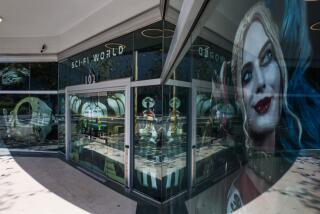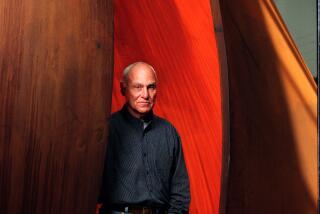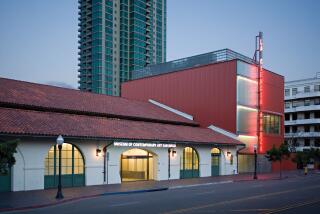Chicago’s Litigious Art of Possession
CHICAGO — This is how most people discover the Terra Museum of American Art: They have a caramel corn craving and find themselves at the end of a very long line to buy the famously delectable offerings of a shop called Garrett Popcorn.
Backed up for half a block on a jammed sidewalk in the pricey heart of this city’s Magnificent Mile shopping district, they wind up beneath a multicolored sign that says “Terra” in front of glass doors that appear to be a storefront.
“It’s a museum!” a man in the popcorn line exclaimed one recent day upon close examination of the door.
It is indeed a museum, with a massive $450-million endowment, an eclectic $100-million collection cobbled together by a wealthy chemical magnate with a healthy ego, and an exceptionally odd location--caramel corn to the right, handmade shoes to the left, $500 Zegna shirts across the street.
Overshadowed for 15 years by retail commerce and criticized by some art historians as the scattered showpiece of a man with more money than artistic sense, the Terra is now being battered in an unseemly intramural legal battle. Two wealthy board members from Chicago are suing three out-of-state members, most notably founder Daniel Terra’s widow, over her plans to pack up the museum and haul it to Washington, D.C.
Judith Terra, 57, who was 32 years her husband’s junior, is portrayed by the plaintiffs in court papers as a gold-digging social climber so coldhearted she kept her dying husband on life support to secure an extra $1.5 million from his estate. Now, they contend, she is trying to move his paintings to Washington, where she lives, merely to impress the political elite.
“Judith Terra owns a home in Washington, D.C.,” the plaintiffs assert in court papers, “and desires to move the foundation there in order for her to obtain a prominent place in the social circles of Washington.”
Illinois Atty. Gen. James E. Ryan, whose office oversees Illinois nonprofit companies, joined the plaintiffs and ratcheted the claims up a notch. Terra and the other defendants, former Sen. Alan K. Simpson of Wyoming and University of Massachusetts art professor Paul Tucker, he alleged, were intentionally “mismanaging Terra Museum in Chicago to create the impression that the museum needs to be closed.”
The defendants, who filed a countersuit Wednesday alleging payoffs, coercion and every type of Chicago-style malfeasance, say the museum has struggled almost since the day in 1980 that Daniel Terra founded it. He first opened it in nearby Evanston, then moved it to Chicago, but the defendants say it may have to be moved again if it is to survive.
Despite the size of the endowment--shared with the collector’s other namesake museum, the Terra Musee d’Art Americain in Giverny, France--the museum loses about $1 million a year. Located in the crowded center of the country’s third-largest city, it draws just 100,000 or so people annually.
And besides, the defendants claim, before his death in 1996, Terra had purchased a building in Georgetown with the intention of moving his foundering museum there.
“This old cowboy now knows what Chicago justice is,” said Simpson on Wednesday from his home in Cody, Wyo. “I’d heard about it, but now I’ve seen the snake in the grass. I mean, I’m chairman of the Buffalo Bill museum here, and we get 250,000 visitors a year--that’s in Cody, Wyo.”
Initially, both sides agreed to sit down with a mediator. The defendants now contend, however, that the attorney general coerced two board members into voting his way by threatening to investigate them on other matters.
In June, the board, which also includes Chicago Mayor Richard M. Daley’s wife, Margaret, approved this “settlement,” defeating Judith Terra and her co-defendants. In July, a Cook County judge approved that agreement, thus blocking, for the moment, any plan to take the museum anywhere.
For good measure, Cook County Circuit Judge Dorothy Kirie Kinnaird ordered that the Terra art remain in the state for at least 50 years--an order that by some interpretations makes it illegal to even show the works outside greater Chicago.
Kinnaird’s order also would force all board members to step down next year, then would fill the board with a majority of Illinois residents for the next 25 years.
The case has implications for the art world. Although the collection contains many second-tier works, it includes classics such as George Caleb Bingham’s “The Jolly Flatboatmen,” Samuel Morse’s “Gallery of the Louvre” and important works by Mary Cassatt, Winslow Homer and Georgia O’Keeffe.
It could also send a sobering message to anyone serving on the board of a nonprofit institution, from the local library to the hospital to the community college. The Terra case, thus far, has shown that if some board members don’t like your vote, they may sue you personally--and perhaps win.
“This is a serious wake-up call to people who sit on nonprofit boards,” said Michael Peregrine, a Chicago attorney who represents numerous nonprofits. “Everybody was doing what they thought was the right thing. Then there are lawsuits and the attorney general says, ‘Hey, you better not do that.’ ”
The inventor of a high-speed photochemical process that helped make possible such photography-based magazines as Life in the 1930s and 1940s, Daniel Terra and his first wife, Adeline, began decades ago buying mostly 19th century American paintings and drawings, hanging the works in their Evanston home. Terra eventually purchased more than 600 pieces.
Terra, a fervent believer in the American way and with a nostalgia for simpler times, became active in conservative politics and served as Ronald Reagan’s chief fund-raiser and later U.S. ambassador at large for the arts, a post Reagan created especially for him.
In 1980, unable to persuade any of America’s premier museums to take his collection and keep it intact, he opened his own museum in Evanston.
In 1986, after Adeline’s death, he married the former Judith Farabee in a Washington ceremony attended by Reagan Cabinet members and various Beltway power brokers. The next year, Terra moved his collection to Michigan Avenue.
The sometimes lurid legal battle began in September 2000, when Chicago-based board members Dean Buntrock, former head of the world’s largest garbage disposal company, Waste Management Inc., and Ronald Gidwitz, former CEO of Helene Curtis, accused fellow board members Terra, Tucker and Simpson of conspiring to spirit the foundation away to Washington.
In the initial complaint, Tucker and Simpson are painted primarily as accessories, with Judith Terra depicted as a ruthless money hound with little regard for art who, after her husband’s death, attempted to seize $43 million of his bequest to the museum.
Ryan, the attorney general, joined the fray with a court brief that made the other complaints against the widow Terra seem trivial. When her late husband had a stroke, the attorney general claimed, Terra kept him on life support until “shortly after midnight on June 28, 1996, the 10th anniversary of his marriage.”
According to their prenuptial agreement, Judith Terra’s share of his estate grew from $3 million to $4.5 million if the marriage lasted 10 years.
“The attorney general hijacked this foundation,” said one of Terra’s attorneys, Robert Cummins. The museum “is underappreciated in Chicago. The number of visitors is abysmal. It’s costing a fortune. And there is no legitimate reason a public attorney general can essentially confiscate a private foundation.”
The attorney general’s office contends it is merely doing its job, overseeing charitable organizations.
Daniel Terra chose the museum site with the idea that it would enjoy maximum visibility and minimum overhead by sharing space with retail shops. Instead, his museum has been all but lost in the river of merchandising that is Michigan Avenue.
Now, regardless of how the legal fight shakes out, the Terra Museum of American Art is likely to vacate its Magnificent Mile location. And whether the art goes to an institution in Washington or another in Chicago, Daniel Terra’s dream of a namesake museum in Chicago’s shopping district seems likely to fade away as well.
More to Read
The biggest entertainment stories
Get our big stories about Hollywood, film, television, music, arts, culture and more right in your inbox as soon as they publish.
You may occasionally receive promotional content from the Los Angeles Times.










